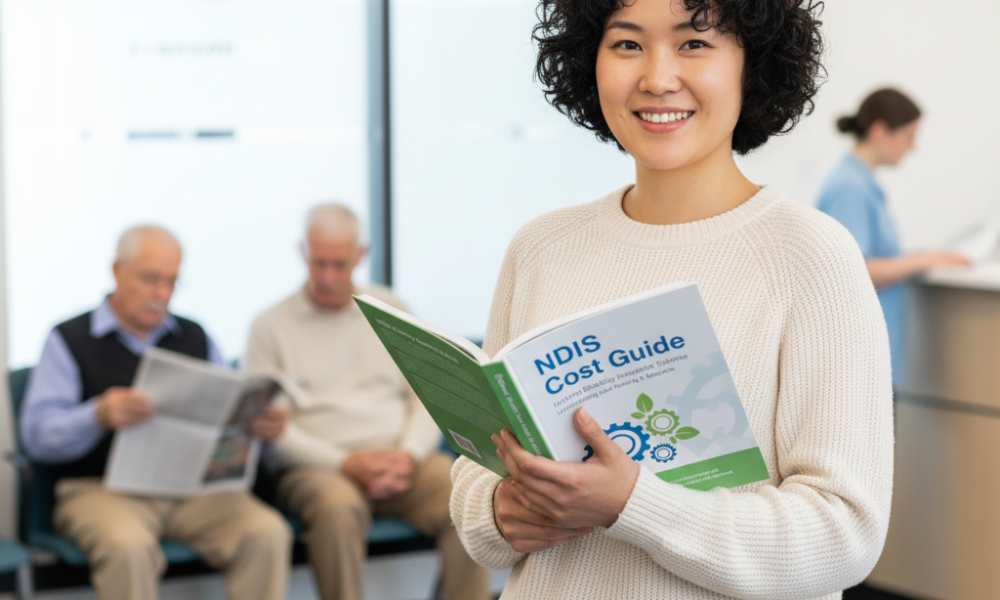Sleepover supports are one of the most cost-effective ways to keep an NDIS Participant safe overnight without paying for an active, awake shift. This guide explains exactly what a sleepover is, how to price for the 2025–26 NDIS Pricing Arrangements, how to bill extra active minutes, what to do in remote areas, and how to handle shared sleepovers fairly and compliantly.
The figures in this blog are price limits (the most a registered provider can claim), not wages. Worker pay is set by the SCHADS Award and employment terms and is usually lower than the billable hourly rate. Providers should ensure wages, penalties and on-costs are covered while staying within the NDIS limits.
Want to Attract More NDIS Clients?
Get expert advice on how to market your services, connect with clients, and grow your practice.
What is an NDIS sleepover?
A sleepover is a continuous eight-hour overnight span where the worker can sleep when not providing support. Up to 2 hours of active support during that span are included in the sleepover fee. If active support goes over 2 hours, only the extra minutes are billed separately at the correct night self-care hourly rate for the time and intensity level. Sleepovers can occur on any day of the week, including public holidays. Note: there is no night-time sleepover support item for nursing.
Pricing
Standard pricing:
- National flat fee: $297.60 per sleepover
- Remote: $416.64
- Very Remote: $446.40
Apply the Remote or Very Remote amount based on the service location’s MMM classification. Use the same loading when billing any extra active minutes.
Remote and Very Remote locations
The NDIS uses the Modified Monash Mode (MMM) to recognise higher delivery costs outside metro areas. In practice, Remote pricing is typically 40 percent higher than the national price and Very Remote is 50 percent higher. Always confirm the exact MMM classification for the service location before you invoice.
Billing extra active minutes (night self-care rates)
When total active time exceeds 120 minutes, bill only the extra minutes at the applicable night self-care rate. For Remote and Very Remote locations, apply the relevant loading to these hourly items as well.
Standard (night):
- Weeknight $78.81/hr
- Saturday $98.83/hr
- Sunday $127.43/hr
- Public Holiday $156.03/hr
High Intensity (night):
- Weeknight $85.27/hr
- Saturday $106.93/hr
- Sunday $137.87/hr
- Public Holiday $168.81/hr
Supporting more than 1 Participant at a time
When a single worker supports multiple NDIS Participants at once, the key is fair apportionment. You should only bill each Participant for the share of support they actually receive, never the full rate for every Participant. Make sure the split and the rationale are agreed in advance with each Participant, then document it clearly in their service agreements and on your invoices and timesheets.
How to document and invoice it cleanly
Put the sharing arrangement in each Participant’s service agreement, including how you split base time, how you handle extras like additional active minutes, travel, or non-face-to-face time, and how often you review the split. On invoices and timesheets, show who the worker supported, when, and how you calculated each Participant’s share. Short notes like “Sleepover shared with [initials]; base split 50–50, +30 mins additional active support to Participant B at [rate]” make audits easy and build trust.
What “fair apportionment” looks like in practice
For shared shifts like sleepovers, group outings, or day programs, decide how you will divide costs before the shift. The split can be equal or proportional to the time and intensity each Participant actually receives. Keep simple written rules that match the scenario, and stick to them.
Example 1: Two housemates sharing a sleepover
One worker covers an eight-hour sleepover for both Participants. You agree to split the sleepover cost 50–50 because their needs are similar. During the night the worker provides 90 minutes to Participant A and 30 minutes to Participant B. You still split the core sleepover fee equally as agreed, then apportion any extra active time beyond the included allowance based on who received it. Your invoice shows: half of the sleepover item to each Participant, plus any additional active minutes charged only to the Participant who received them.
Example 2: Three Participants on a community outing
A support worker takes three Participants to a two-hour art class. Everyone travels together and attends the same activity. You charge each Participant one-third of the worker time, one-third of the travel time, and one-third of any non-labour travel costs. If one Participant needs one-to-one assistance for 20 minutes during the session, that extra 20 minutes is billed only to that Participant.
Example 3: SIL home with variable needs
In a shared SIL home, a rostered worker supports two Participants. You set an equal split for base hours, but one Participant has higher personal care needs in the evening. You apportion the base hours 50–50 and then allocate the additional evening support time to the Participant who received it. Review the apportionment monthly to confirm it still reflects actual support patterns, and update the agreement if needs change.
Worked Pricing examples
1) Weeknight sleepover, 90 minutes active (Standard).
Invoice: 1 × Sleepover $297.60. No extras. Total $297.60.
2) Weeknight sleepover, 3 hours active (Standard).
Invoice: 1 × Sleepover $297.60 + 60 minutes at Weeknight Standard $78.81/hr.
Total $297.60 + $78.81 = $376.41.
3) Sunday sleepover in Very Remote area, 2.5 hours active (Standard).
Invoice: 1 × Sleepover $446.40 + 30 minutes at Sunday Standard $127.43/hr × 1.50.
Extra = $95.57. Total $446.40 + $95.57 = $541.97.
4) Two housemates share a weeknight sleepover, 2.5 hours active total (Standard).
Agreed split: 50–50 on the flat fee. Active minutes: A = 60, B = 90 (30 minutes over the included 120).
Invoice A: $148.80 (half the sleepover).
Invoice B: $148.80 + $39.41 (30 min × $78.81/hr) = $188.21.
The Significance of NDIS Pricing Arrangements and Price Limits
The NDIS Pricing Arrangements and Price Limits are the rulebook for nights. They set the maximums you can claim for each overnight model and keep billing consistent, transparent, and fair for Participants and providers.
Clarity on the two overnight models
Sleepovers use a flat fee for an eight-hour span that includes up to two hours of active support; any time beyond that is billed separately at the correct night self-care rate. Active, awake overnights are billed hourly at night rates. Using the right item protects Participant funds and avoids rejected claims.
Value for money, in practice
Price limits encourage you to match the model to the need. If the Participant usually needs brief or infrequent help overnight, a sleepover stretches the plan further; if support is frequent or extended, active overnight is the right, fund-aligned choice.
Fair competition on quality
Because the price is capped, providers compete on reliability, worker skill, documentation quality, and outcomes. Clear overnight terms in service agreements and invoices build trust and help Participants compare providers.
Guardrails against overcharging
The limits stop double-charging on shared nights and prevent billing more than the included two hours without itemising the extra time. Accurate recording of active minutes, start/finish times, and items used keeps you audit-ready.
Serving regional needs the right way
Remote and Very Remote loadings apply to the sleepover fee and to any extra active minutes. Using the service location’s MMM classification ensures the Participant is charged correctly without under- or over-recovering costs.
Annual reset and operational updates
The guide usually updates from 1 July. Each year, refresh your overnight roster costs, service agreement clauses, and invoice templates so sleepover fees, night rates, and any remote loadings reflect the new limits from the first shift of the new year.
Consequences of non-compliance
Going over the cap leads to claim rejections, repayment requests, and audit exposure. A simple pre-shift check of item, day/time, location rate, and documentation requirements keeps overnight billing clean and compliant.
Referrals Start With Reputation – We’ll Help You Build Both
From networking tips to service refinement, we guide NDIS providers toward lasting impact.
FAQ’s
1. Does a sleepover include public holidays?
Yes. The flat fee applies any day. If you exceed two hours of active support, the extra minutes use the correct day’s night rate, including public holidays.
2. Can I bill a nurse sleepover?
No. There is no night-time sleepover item for nursing supports.
3. What if a Participant needs frequent overnight help?
If active support routinely exceeds two hours, consider moving to an active, awake overnight model and discuss funding with the Participant and their planner.
4. How often should we review a shared arrangement?
Monthly works well, or sooner if support needs change.
5. How long is a sleepover?
Eight continuous hours overnight. The single sleepover item covers that full span.
6. Is the “up to 2 hours” included time per Participant or per sleepover?
It’s per sleepover span. Track who received the support. If total active time across the span exceeds 120 minutes, bill only the extra minutes to the Participant(s) who received them.
7. Which rate do I use for extra minutes over 2 hours?
Use the night Assistance with Self-Care hourly rate that matches the exact time and intensity level. If the shift crosses midnight into Saturday, Sunday, or a public holiday, split the extra minutes at the changeover.
8. Do public holidays change the sleepover flat fee?
No. The flat fee is the same on any day. Only extra minutes beyond 2 hours use the public holiday night rate.
9. How do Remote and Very Remote loadings apply?
Apply the Remote or Very Remote sleepover amount based on the service location’s MMM classification. Use the same loading on any extra minutes billed during the sleepover.
10. What records should I keep for a clean claim?
Start and finish times, total active minutes, a simple breakdown of who received any extra minutes, the day type (weekday, Saturday, Sunday, public holiday), and the service location’s MMM status.
11. Can I claim two full sleepovers if one worker supports two Participants?
No. Claim one sleepover and apportion the flat fee fairly between Participants. Bill any extra minutes only to the Participant who received them.
12. What if the Participant regularly needs more than 2 hours of help overnight?
Move to an active, awake overnight model and update the service agreement. This keeps claims aligned with the Participant’s actual needs.
13. How should I choose the intensity level for extra minutes?
Match the minutes to the support actually delivered. If a Participant requires high-intensity support, apply the high-intensity night rate to that Participant’s extra minutes only.
14. Can I use a sleepover item for a shorter night (for example, 6 hours)?
The sleepover item is defined as eight hours. If the rostered cover is materially shorter, consider using the appropriate hourly night support items instead.
15. What happens if I go over the price limits?
Claims may be rejected or require repayment. Check the current year’s price limits before the shift and ensure your invoices reflect the correct item, day/time, location rate, and any extra minutes.
16. Do I need to do anything special when two Participants share a sleepover?
Yes. Agree the split in advance, include it in each Participant’s service agreement, and reflect it on invoices and timesheets. Review regularly and update if needs change.
17. How should I handle cancellations for sleepovers?
Follow the short-notice cancellation rules applicable to the item in the current Pricing Arrangements, and make sure your service agreement sets out your cancellation terms clearly.
18. Does the included 2 hours reset at midnight?
No. The included 120 minutes applies to the single eight-hour sleepover span, even if it crosses midnight. Only the rate for extra minutes may change at midnight if the day type changes.


